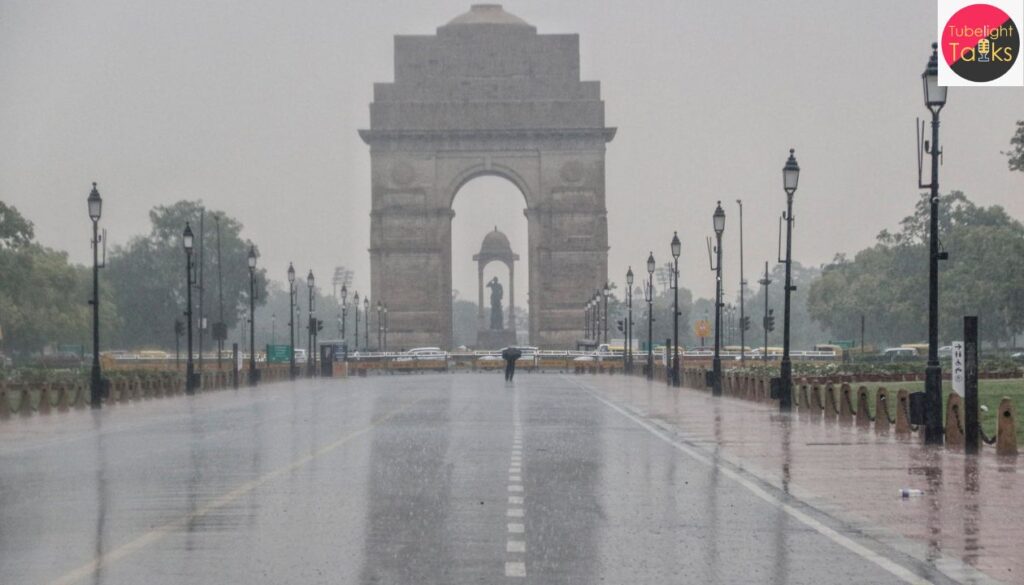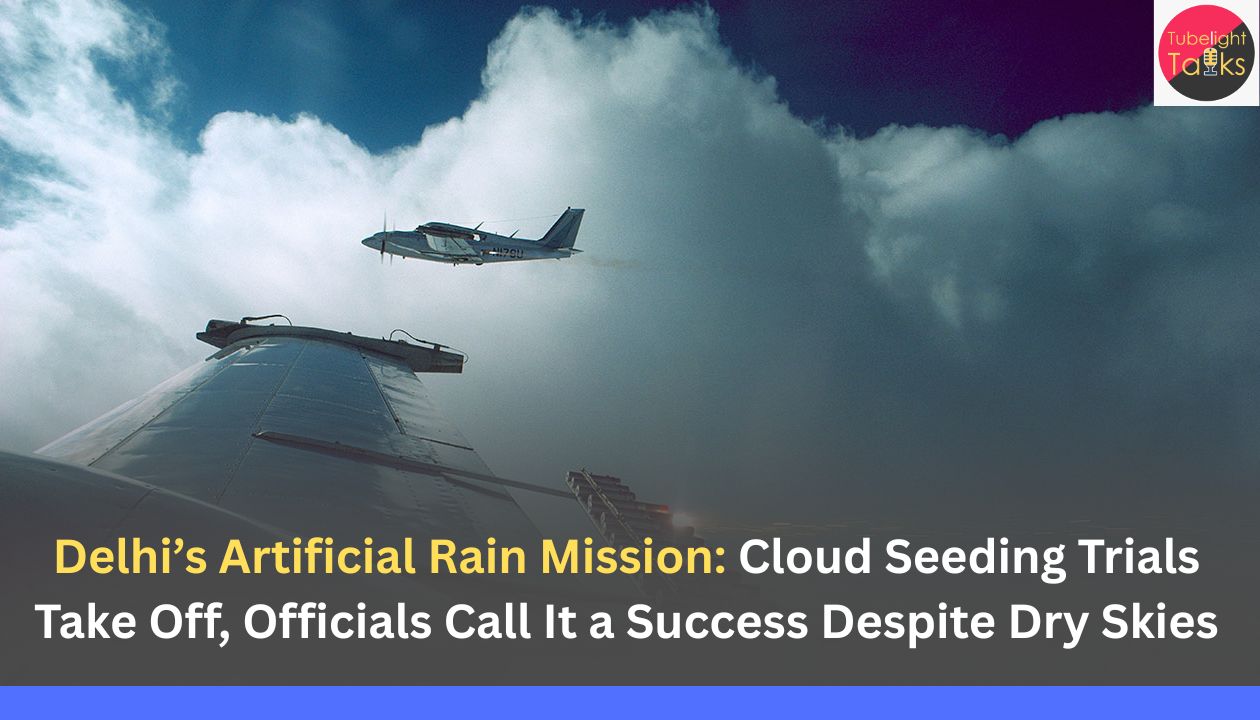Artificial Rain Mission: For the first time, Delhi’s sky turned into a testing ground for science as the national capital carried out its maiden cloud seeding trials to induce artificial rain. The Delhi government, in collaboration with IIT Kanpur, launched this ambitious project to tackle the city’s worsening air pollution crisis ahead of the winter season. While the trials have not yet resulted in rainfall, officials have termed the experiment a success, calling it the first crucial step toward exploring new ways to clear Delhi’s toxic air.
Key Takeaways from Delhi’s Cloud Seeding Experiment
- First-Ever Cloud Seeding Over Delhi: The Delhi government and IIT Kanpur jointly conducted artificial rain trials over Burari, Karol Bagh, Mayur Vihar, Bhojpur, and Sadakpur.
- Low Humidity Challenges: With only 15–20% humidity in the atmosphere , far below the 50–60% required ,the trials could not generate rain despite chemical dispersal.
- Government’s Long-Term Plan: An MoU worth ₹3 crore was signed between Delhi and IIT Kanpur for five trials, with 9–10 more planned in coming days based on weather conditions.
- Scientific Method Used: Silver iodide and sodium chloride particles were released from a Cessna aircraft to stimulate rain-bearing clouds.
- Experts Caution on Results: Meteorologists say cloud seeding cannot create rain from dry clouds and may have minimal short-term impact on pollution levels.
Science Meets Sky: How the Experiment Unfolded
Around 1:30 pm on Tuesday, a Cessna aircraft from IIT Kanpur took off from Kanpur and flew over northwest Delhi, releasing a mixture of silver iodide and sodium chloride into the clouds above Burari, Mayur Vihar, and Karol Bagh. The process was repeated between 3:30 pm and 4:15 pm in the same areas.
According to officials, humidity levels in the clouds hovered between 15–20%. While the ideal range for successful cloud seeding is 50–60%, the team went ahead with the exercise to gather data and analyze atmospheric response. Officials said the city could experience light rainfall between 5 and 6 pm, though the India Meteorological Department (IMD) confirmed that no rain was recorded after the trial.
This was the second round of seeding, following an earlier attempt on October 23 that also failed to induce rainfall due to minimal moisture levels.
What is Cloud Seeding and Why Delhi Tried It
Cloud seeding is a scientific weather modification technique that introduces chemicals like silver iodide (AgI) or salt particles into clouds to accelerate condensation and trigger rainfall. The process helps convert moisture into raindrops, potentially improving air quality by washing out pollutants.
However, successful cloud seeding depends on suitable cloud formations and sufficient atmospheric moisture. Without these conditions, experts warn that the method cannot create rain from thin air.
Delhi Chief Minister Rekha Gupta described the experiment as “a necessity for Delhi” and called it “a pioneering step to address the city’s environmental challenges.” Speaking to ANI, she said, “We want to see if this can help control Delhi’s serious air pollution problem. With the blessings of Delhi’s people, we are confident this will lead to a breakthrough.”
Scientific Reality: Experts Urge Patience
While the Delhi government declared the experiment a “success,” experts have urged caution in interpreting the results. According to Manjinder Singh Sirsa, Delhi’s Environment Minister, the team from IIT Kanpur explained that it could take anywhere between 15 minutes to four hours for rainfall to occur after seeding , but due to low humidity, significant rainfall was unlikely.
Weather experts from the IMD stated that there were no rain-bearing clouds forecast over Delhi for the next week. The IMD predicted partly cloudy skies, mist, and fog but no rainfall due to the absence of western disturbances , the key systems responsible for bringing moisture-laden clouds to northern India.
Akshay Deoras, a research scientist at the National Centre for Atmospheric Sciences, University of Reading, emphasized that “cloud seeding does not produce rain from scratch. It only helps rain-bearing clouds to rain faster or sooner. It’s not like magic.”
Also Read: Climate Tipping Point Crossed: Global Coral Reefs Face Irreversible Collapse
Global and National Context: Learning from Other Experiments
India is not new to cloud seeding experiments. The Indian Institute of Tropical Meteorology (IITM), Pune had previously conducted cloud seeding in Maharashtra’s Solapur district in 2018 and 2019. According to scientist Thara Prabhakaran, who worked on the project, it took nearly two years and over 200 flights to achieve measurable results , an 18% increase in rainfall on average.

“Each cloud behaves differently,” said Prabhakaran. “Cloud seeding depends on multiple variables ; wind speed, cloud type, and moisture levels. One or two trials cannot prove success; it needs repeated experimentation under varied conditions.”
Similarly, countries like China, the UAE, and Australia have used cloud seeding for decades to induce rain during droughts or to clear haze. Yet, studies also indicate that under unfavourable meteorological conditions, seeding can temporarily increase PM2.5 levels instead of reducing them.
Government’s Next Step: More Trials Ahead
The Delhi government and IIT Kanpur have planned 9–10 additional cloud seeding trials in the coming days, depending on weather suitability. The aim, officials say, is to gather scientific data about rainfall behavior under different humidity levels to frame a long-term pollution-control strategy.
The ₹3 crore MoU between the Delhi government and IIT Kanpur covers five trials, making this the first large-scale artificial rain initiative ever conducted in the capital. The project, initially scheduled for May, was delayed several times due to unfavourable weather.
Delhi Environment Minister Sirsa said, “If IIT Kanpur’s trials succeed, we will prepare a long-term plan to use cloud seeding in Delhi until February to reduce air pollution.”
Can Artificial Rain Really Clean Delhi’s Air?
While the initiative has captured public imagination, environmentalists caution that artificial rain is only a temporary fix. Sunil Dahiya, founder of Envirocatalysts, noted, “Measures like smog towers, smog guns, or cloud seeding are only cosmetic. They may create short-term visibility but no long-term improvement. To truly clean Delhi’s air, we must tackle pollution sources like transport, construction, and power generation.”
Experts agree that while cloud seeding could offer short bursts of relief during peak pollution, the city needs a comprehensive and sustainable strategy for air quality management.
Still, Delhi’s experiment marks a turning point ; a rare instance of science and governance joining hands to fight one of India’s gravest environmental challenges. Whether these clouds finally burst into rain or not, the mission has opened a new conversation about innovation, environment, and the desperate need to reclaim Delhi’s blue skies.
The Supreme Power Behind Nature’s Balance
Rain, wind, and sunlight , all are divine gifts of nature . In earlier times, when there was no rainfall, people performed Communal Feast (Bhandaras), and the rain followed. This shows that when humans purify their thoughts and actions, nature supports them.
Tatvdarshi Saint Rampal Ji Maharaj Ji, the present incarnation of Supreme God Kabir Saheb, explains that performing the five true Yajnas mentioned in the scriptures pleases the Almighty, maintaining harmony in the environment. The Srimad Bhagavad Gita also provides evidence of this divine connection.
While technology has its importance, true balance in life and nature can only be achieved by connecting with the Supreme Power, the Creator of this entire universe.
For more spiritual knowledge, visit: www.jagatgururampalji.org
FAQs on Delhi’s Cloud Seeding and Artificial Rain Trials
1. What is cloud seeding and why is Delhi using it?
Cloud seeding is a weather modification process using silver iodide or salts to trigger rain, aimed at reducing Delhi’s severe air pollution levels.
2. Where were Delhi’s cloud seeding trials conducted?
The trials were conducted over Burari, Karol Bagh, Mayur Vihar, Bhojpur, and Sadakpur areas using an IIT Kanpur aircraft.
3. Did the cloud seeding trials cause rainfall in Delhi?
No rainfall was recorded as humidity levels were only 15–20%, below the 50–60% required for successful cloud seeding.
4. Who conducted Delhi’s cloud seeding experiment?
The Delhi government partnered with IIT Kanpur under a ₹3 crore MoU to carry out artificial rain trials to combat pollution.
5. Will cloud seeding permanently solve Delhi’s air pollution?
Experts say cloud seeding offers only short-term relief; long-term air quality improvement requires addressing pollution sources like vehicles, construction, and power plants.










